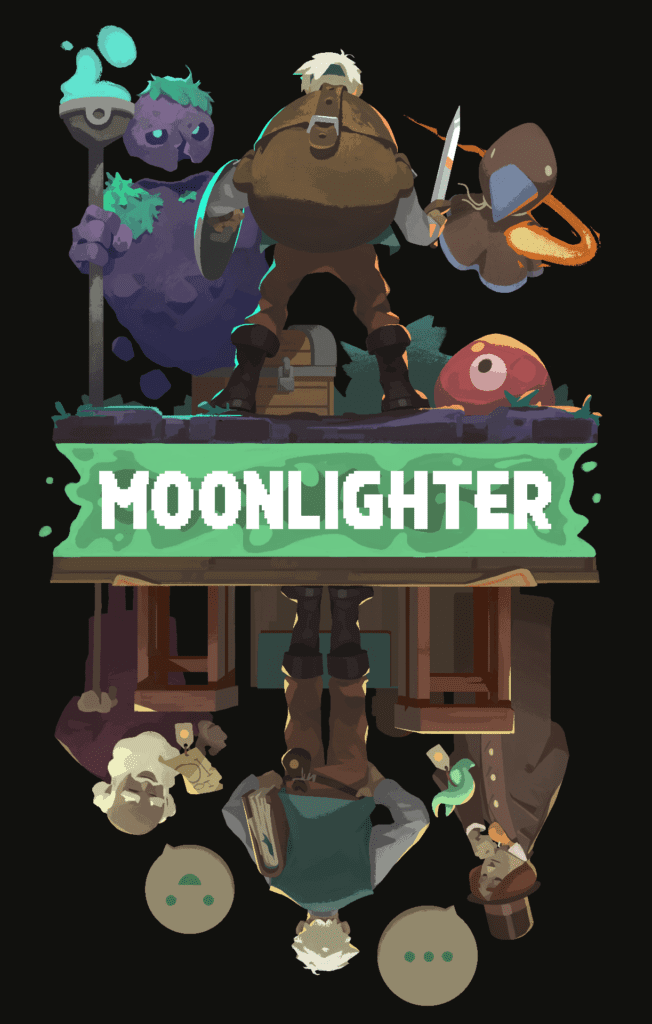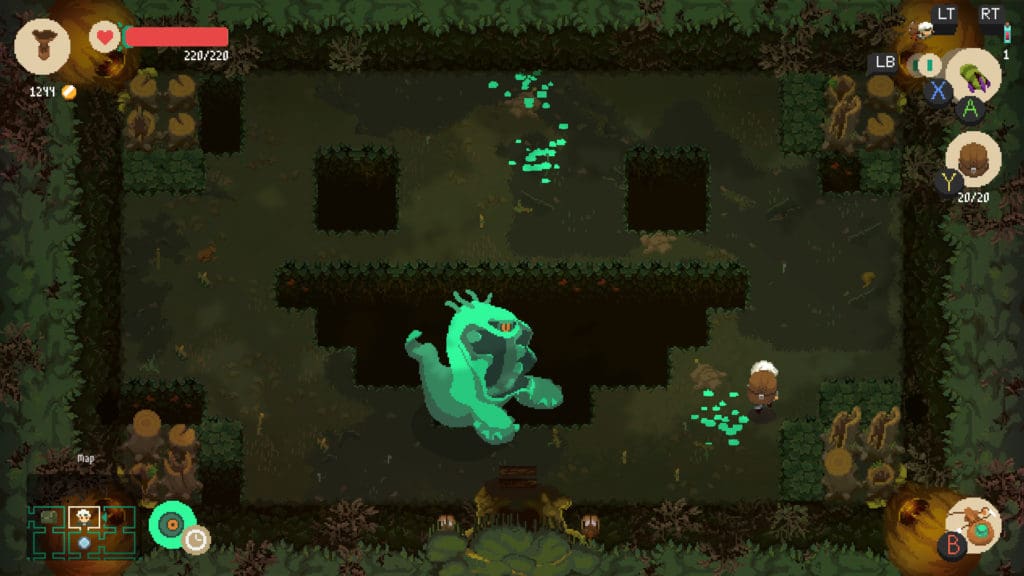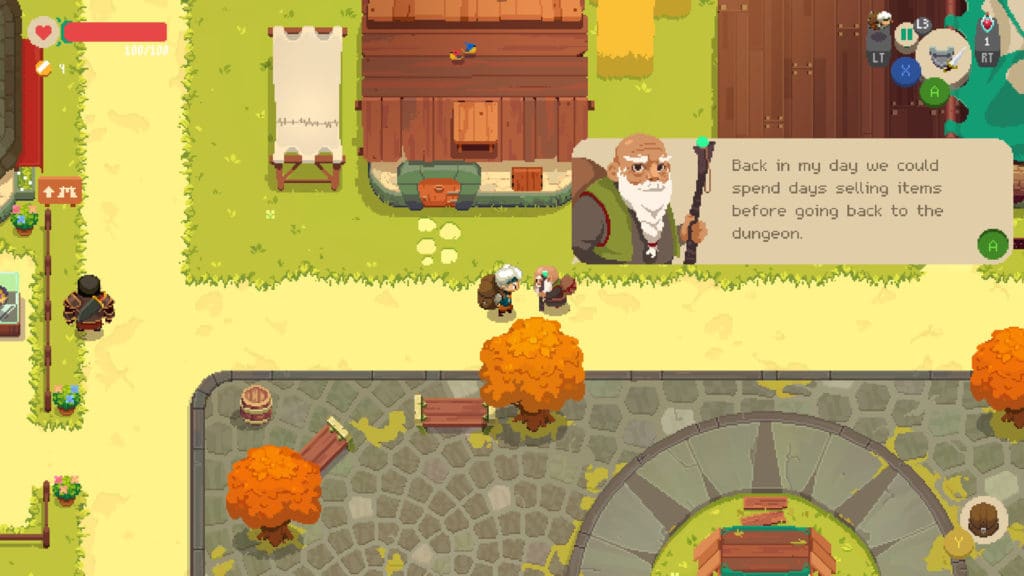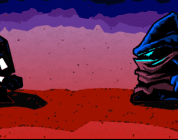Created by 11 Bit Digital and Digital Sun Moonlighter is an attempt at crossing Action RPGs, rogue-lites, and shopkeeping simulators. While an interesting concept and entertaining, “Moonlighter” soon loses its novelty after about five or ten hours of gameplay.
The game revolves around Will, the owner of a small store called “Moonlighter.” Bored of his life as a merchant in a struggling town and determined to revitalize his dreams of being an adventurer, Will ventures into the nearby Dungeons. In short, he’s a shopkeeper who moonlights as an adventurer.
 These dungeons are as rife with treasure as they are with danger. For a while after their discovery, adventurers from far and wide hastened to them for glory and fortune. Will’s town, Rynoka, was conveniently nearby the excavation site and thus profited from whatever the adventurers found and had to sell. Finding the dungeons too dangerous, though, people slowly stopped visiting them, thus stagnating Rynoka’s commerce.
These dungeons are as rife with treasure as they are with danger. For a while after their discovery, adventurers from far and wide hastened to them for glory and fortune. Will’s town, Rynoka, was conveniently nearby the excavation site and thus profited from whatever the adventurers found and had to sell. Finding the dungeons too dangerous, though, people slowly stopped visiting them, thus stagnating Rynoka’s commerce.
Soon after starting Moonlighter, however, I discovered that it is nearly impossible to die in a dungeon. An in-game note states that the dungeon spits someone back into the real world as soon as they pass out from fatigue or pain. So could someone explain to me what’s so dangerous about these dungeons and, furthermore, how I keep finding moldering skeletons in them?
The game places little emphasis on its story overall. The plot, if anything, is simply a backdrop for the game’s mechanics and the far more interesting lore. In order to run your shop, you must dive into the dungeons and procure items to sell. In order to progress through the dungeons, you must make enough money to buy the best weapons and armor you can get your hands on.
In the tutorial, Will is shown how to set prices on his inventory, watch customer reactions, and adjust prices accordingly. The grandfatherly figure who guides you through this, Zenon, also warns that you might flood the market if you sell too much of a popular item. The nuance of combating supply and demand in a dungeon crawler was certainly enticing and suggested a dynamic game. Paired with rather amusing moments, the game started out with promise. Heck, the old man gives the first weapon and says “It’s dangerous to go alone. Take this!” If that sort of tongue-in-cheek reference is not promising, I don’t know what is!
The sense of promise was heightened when I took my first step outside. There in the night-shrouded town, soft, subtle music drifted through the air. As I explored, I found myself mesmerized by a group of fireflies as they lazed over the village square; minute lanterns suspended in the evening.
An eager grin on my face, I soon found myself diving into dungeons and returning to enrich myself.
Again. And again. And again.
Where Things Went Downhill
The store mechanic was the first thing to lose its appeal. While it was still somewhat interesting to set my own prices, it turned out that, once I found the optimal price, the game would set it automatically. Convenient at first, players soon discover that supply and demand do NOT actually exist in this game. So long as you do not set the price too high, someone is bound to buy what is being sold and thus the auto-price is always what ends up being used. After a while, being a merchant in this game devolved into watching customers mill around the store, hemming and hawing over whether they want to buy stuff, which they inevitably will. Even people asking for something specific will buy whatever junk is available.
One woman even came in looking for weapons and bought a leaf instead. Not even a crafting ingredient. Just a leaf.
 Every now and then, a thief would wander into the store and I would enact a Loony Toons-style brawl to kick him out, but that was the only action introduced aside from furiously restocking shelves. For crying out loud, the thieves would even come in with a bandit mask in their speech bubble, as if shouting “Hey! I’m I’m gonna steal your stuff! Drop-kick me please!” Otherwise, there was nothing to manage nor anything that would impede sales. Instead of a store simulator, the shop mechanic felt more like a standard inventory dump. Imagine Skyrim, except that whenever a store is visited there is a long loading screen and a dull mini-game to deal with. The combat and dungeon diving was redeeming though!
Every now and then, a thief would wander into the store and I would enact a Loony Toons-style brawl to kick him out, but that was the only action introduced aside from furiously restocking shelves. For crying out loud, the thieves would even come in with a bandit mask in their speech bubble, as if shouting “Hey! I’m I’m gonna steal your stuff! Drop-kick me please!” Otherwise, there was nothing to manage nor anything that would impede sales. Instead of a store simulator, the shop mechanic felt more like a standard inventory dump. Imagine Skyrim, except that whenever a store is visited there is a long loading screen and a dull mini-game to deal with. The combat and dungeon diving was redeeming though!
Until I got to the second dungeon, that is.
The Dungeon Grind
I spent more time than necessary playing in the first dungeon in order to experiment with the different weapons available: the sword and shield, the big sword, the spear, the fists, and the bow and arrows. Starting with a sword and shield, the game demanded quick reactions and agile movements in order to survive. Challenging and entertaining at first, the weapon(s) soon lost their appeal when I could only manage one or two strikes on an enemy before I had to dodge. The shield also did diddly-squat. It was difficult to aim and, even if I managed to block something, it only slightly reduced the damage. Considering how quickly health depletes in Moonlighter, it was both easier and more viable to just keep dodging and come in for the occasional quick jab like a Dark Souls player or a bad ex.
 Once I started using the Big Swords, however, I found that I was nearly untouchable. Get the timing right and BAM, knock back five enemies before they can even retaliate and then the return swing finishes them off as they charge back in like lemmings. Although rather satisfying at first, the combat became akin to pest control after a while: Enter room, wait for tiny monstrosities to charge, smash them into jelly, rinse, repeat. There were other, more populated rooms that made things certainly more interesting, though. At times, the game verged on leaving the Action RPG realm and turned into a Bullet Hell.
Once I started using the Big Swords, however, I found that I was nearly untouchable. Get the timing right and BAM, knock back five enemies before they can even retaliate and then the return swing finishes them off as they charge back in like lemmings. Although rather satisfying at first, the combat became akin to pest control after a while: Enter room, wait for tiny monstrosities to charge, smash them into jelly, rinse, repeat. There were other, more populated rooms that made things certainly more interesting, though. At times, the game verged on leaving the Action RPG realm and turned into a Bullet Hell.
Overall, going through the dungeons often became tedious. If I died at the boss, I would have to go through all three floors again, clearing out swaths of low-level enemies that often cannot be avoided just to get to the interesting bits. If underpowered, players will likely need to grind through a dozen dungeons in order to get the materials and money necessary to upgrade equipment. It was the same pitfall that the Diablo franchise and similar dungeon crawlers repeatedly fall into.
That being said, the boss fights in Moonlighter are WONDERFUL. The first one, although a bit easy and simplistic, had a soundtrack that was both beautiful and cinematic. The music reminded me of some of the boss fight music in the Kingdom Hearts series. I felt like a dungeon-crawling Cloud Strife as I dodged attacks and came in swinging with a sword as big as me! The next boss lacked the lustrous soundtrack, but was so challenging and entertaining that I scarcely noticed. These bosses almost compensated for the twenty or thirty minutes of dungeon grinding and often annoying music that I had to endure getting back to them each time I died.
Almost.
Moonlighter boasts that each time a dungeon is entered, enemies and rooms will be arranged differently. While interesting at first, it just made getting to the boss that much more tiresome, not knowing where to go. Also, the enemies almost always come in the same groupings.
Furthermore, the combat mechanics never changed. Using a big sword and upgrading to the next version felt like it was just the same thing. Maybe it would do a different kind of damage or perhaps inflict a brief status effect, but that was it. The only way any variety in combat was found was by changing the weapon style entirely which, by mid-game, became a massive investment that simply was not worth the time or expense. Once a fighting style is chosen, it is usually in the player’s best interests to stick to it. Luckily there is the ability to switch between two weapons on the fly to deal with various enemies. That’s about as much evolution as the combat ever saw. No upgrades that change how players tackle various challenges like in The Binding of Isaac or Moon Hunters, no abilities like Diablo, nothing.
Each dungeon then turned out to be essentially a repeat of the first and the glitches did not make things better. For example, some monsters make a squelching sound and sometimes that sound never went away until I left the entire dungeon. Frankly, that just made me wonder what was going on behind the next door and whether I was about to walk in on something… The map often did not appear either and items occasionally flew away from me until they disappeared like all of the eligible women in my life.
I thus found myself more interested in organizing my inventory than in clearing a room of monsters. Granted, various items had “curses” on them, which created requirements for how they were packed or they might destroy adjacent items. Because of that, what was normally dull inventory management became a puzzle, which is a huge plus in the game’s favor.
The Draw
Honestly, though, the only thing that really motivated going back and forth between the dungeons and shop was the dungeons’ lore. Each item has a description attached to it and various books and scribbles can be picked up were particularly enlightening. Paired with the sometimes whimsical notes left behind by previous adventurers, I got a far better sense of the story and the world than I did from talking to people. It seems that, yet again, Moonlighter has taken a leaf from the Dark Souls book.
However, in this case, the game might outdo the Soulsborne franchise. Going through each dungeon,items give pieces of information, much like in Soulsborne. In Moonlighter, however, information is attained as if reading a diary that has been scattered. Although it lacks the depth of the lore in Souls, Moonlighter‘s lore is still interesting and does not require a wiki and three forums to explain how things connect.
Moonlighter also allows the player to invest in their hometown. Zenon repeatedly says, essentially, “We need to revive this dying town, ya dumb kid! Go pay for some other merchant to come here!” As a silent protagonist, though, Will’s motivations are never stated. The player can either interpret what they see or imprint their own motivations onto Will. Perhaps Will is a saintly figure, spending his hard-earned money on bringing in new merchants for the town’s sake. Perhaps he’s a selfish S.O.B. who only wants the smith so that he can get better armor and wants the banker in order to become Rynoka’s version of Scrooge McDuck. Or maybe the player is just bored and wants to dump their money into SOMETHING and see what happens.
Granted, Will made his first trip into a dungeon with only a broom, so maybe motivations are too much to ask of him.
Moonlighter is entertaining for short bursts. This is not a game that will have the player lost in for hours on end. As an “Action RPG with rogue-lite elements,” the game is nothing new and does not boast the gameplay diversity of other rogue-lites. That being said, the game is simply, yet beautifully animated, the controls are fluid and almost flawless, and the lore can be tantalizing when looking for the next piece of the puzzle.
That said, the various bugs and almost endless grinding are not so enjoyable. The shop mechanic, while a wonderful idea and joyous to play at first, does not seem to have reached its full potential. The musical score can range from the aforementioned epic melodies to wonderfully soothing and complementary themes to nerve-twinging, repetitive dungeon/elevator music.
Players who pick up Moonlighter had best love both dungeon grinding and shop-based mini games. Ignoring the shop will only result in having to do so to progress and ignoring the dungeons will result in a lack of things to sell.
In short, both sides need to be loved to truly enjoy Moonlighter.
For more information on Moonlighter, check out the official site.





